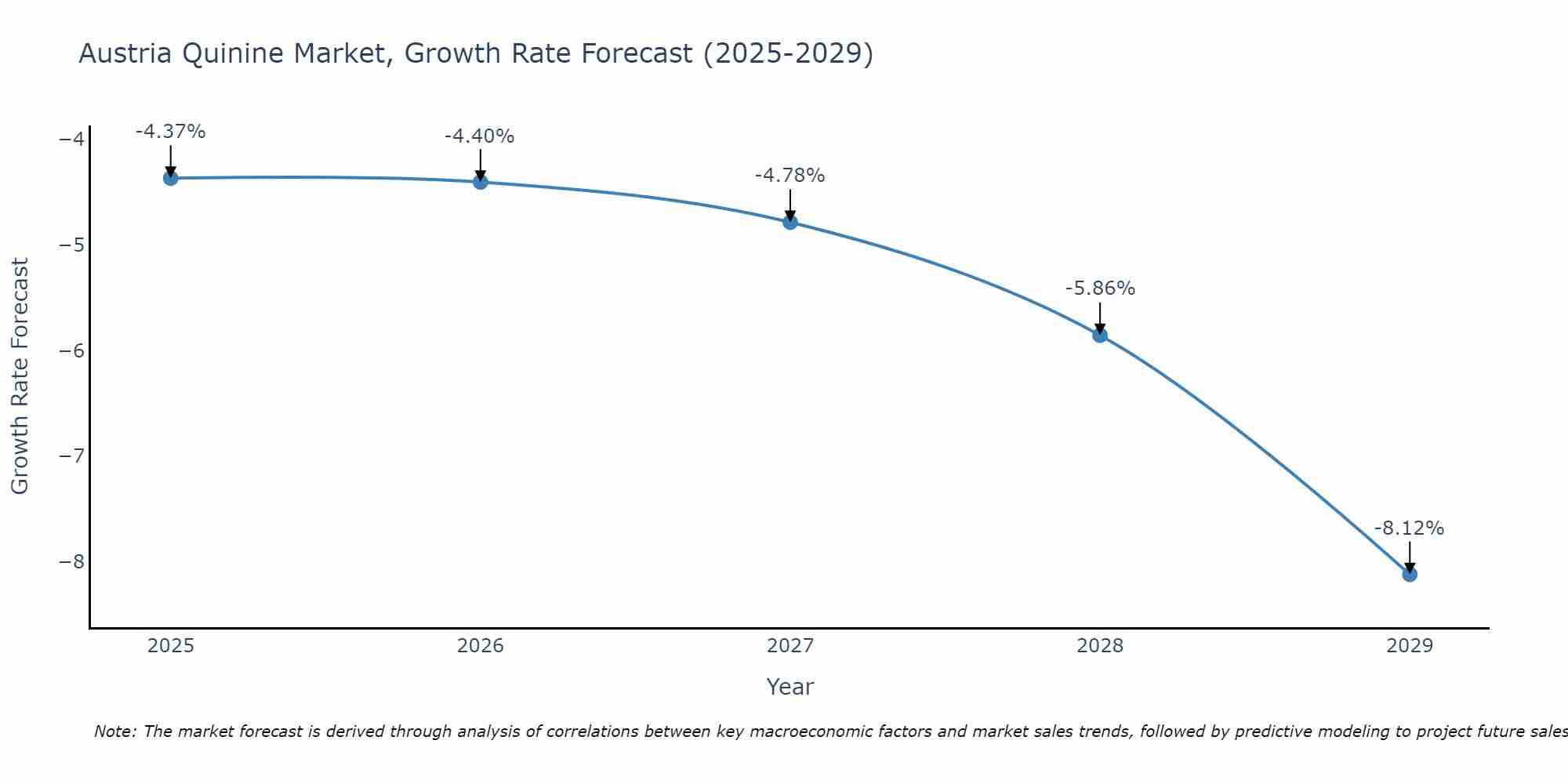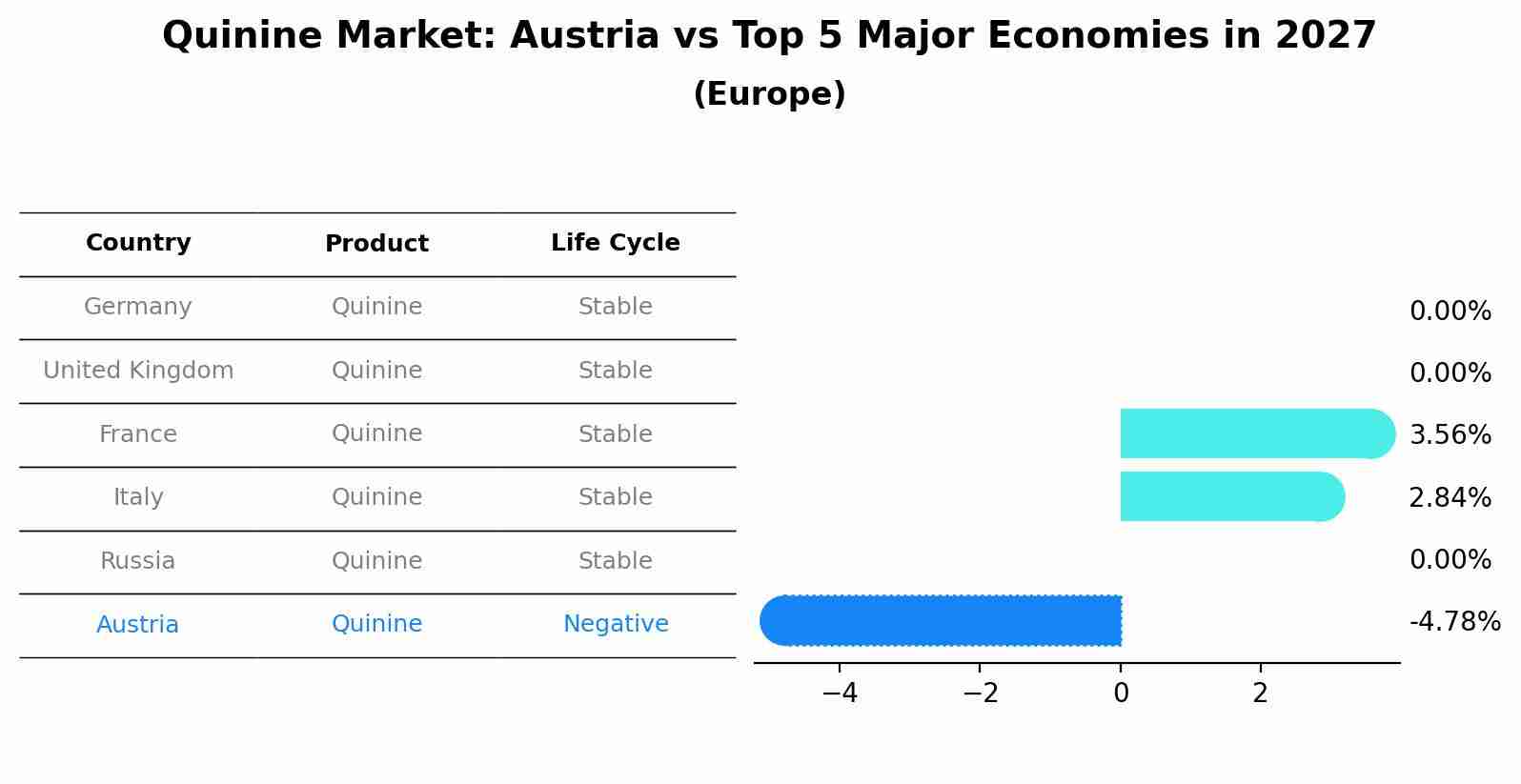Austria Quinine Market (2025-2031) | Segmentation, Trends, Forecast, Value, Growth, Industry, Analysis, Companies, Revenue, Share, Outlook & Size
| Product Code: ETC5312418 | Publication Date: Nov 2023 | Updated Date: Sep 2025 | Product Type: Market Research Report | |
| Publisher: 6Wresearch | Author: Ravi Bhandari | No. of Pages: 60 | No. of Figures: 30 | No. of Tables: 5 |
Austria Quinine Market Size Growth Rate
The Austria Quinine Market may undergo a gradual slowdown in growth rates between 2025 and 2029. Beginning strongly at -4.37% in 2025, growth softens to -8.12% in 2029.

Quinine Market: Austria vs Top 5 Major Economies in 2027 (Europe)
By 2027, Austria's Quinine market is forecasted to achieve a negative growth rate of -4.78%, with Germany leading the Europe region, followed by United Kingdom, France, Italy and Russia.

Austria Quinine Market Overview
The quinine market in Austria is primarily driven by the pharmaceutical industry, given its use in the treatment of malaria and as a muscle relaxant. The market is influenced by global demand and supply dynamics, regulatory approvals, and advancements in medical research. Austrias stringent regulatory framework ensures high standards of quality and safety for quinine products.
Drivers of the market
The quinine market in Austria is driven by its extensive use in the pharmaceutical industry, particularly for treating malaria and as a muscle relaxant. Additionally, the demand for quinine in the beverage industry, especially for tonic water, boosts its market growth. Increasing awareness of quinine`s medicinal properties and its applications in treating leg cramps and arthritis also contribute to market expansion. Regulatory support and the presence of established pharmaceutical companies further propel the market.
Challenges of the market
The quinine market in Austria faces significant challenges due to stringent regulatory standards that control the use of quinine in pharmaceutical and food products. The high cost of raw materials and extraction processes adds to production expenses, making it difficult for local producers to compete with cheaper imports. Additionally, the increasing availability of synthetic alternatives to quinine is impacting demand for natural quinine products. Environmental concerns and sustainable sourcing of cinchona bark, the primary source of quinine, also pose challenges, as deforestation and habitat destruction affect supply chains.
Government Policy of the market
The Austrian quinine market, primarily driven by its use in pharmaceuticals and beverages, is subject to strict regulatory standards. The Austrian Agency for Health and Food Safety (AGES) oversees the import, distribution, and use of quinine, ensuring compliance with EU directives. Government policies focus on maintaining high safety standards and ensuring the traceability of quinine sources to prevent contamination and ensure public health.
Key Highlights of the Report:
- Austria Quinine Market Outlook
- Market Size of Austria Quinine Market, 2024
- Forecast of Austria Quinine Market, 2031
- Historical Data and Forecast of Austria Quinine Revenues & Volume for the Period 2021-2031
- Austria Quinine Market Trend Evolution
- Austria Quinine Market Drivers and Challenges
- Austria Quinine Price Trends
- Austria Quinine Porter`s Five Forces
- Austria Quinine Industry Life Cycle
- Historical Data and Forecast of Austria Quinine Market Revenues & Volume By Mode of Administration for the Period 2021-2031
- Historical Data and Forecast of Austria Quinine Market Revenues & Volume By Oral Administration for the Period 2021-2031
- Historical Data and Forecast of Austria Quinine Market Revenues & Volume By Intravenous Administration for the Period 2021-2031
- Historical Data and Forecast of Austria Quinine Market Revenues & Volume By Intramuscular Administration for the Period 2021-2031
- Historical Data and Forecast of Austria Quinine Market Revenues & Volume By Others for the Period 2021-2031
- Historical Data and Forecast of Austria Quinine Market Revenues & Volume By Application for the Period 2021-2031
- Historical Data and Forecast of Austria Quinine Market Revenues & Volume By Antimalarial for the Period 2021-2031
- Historical Data and Forecast of Austria Quinine Market Revenues & Volume By Antipyretic for the Period 2021-2031
- Historical Data and Forecast of Austria Quinine Market Revenues & Volume By Others for the Period 2021-2031
- Historical Data and Forecast of Austria Quinine Market Revenues & Volume By End-user for the Period 2021-2031
- Historical Data and Forecast of Austria Quinine Market Revenues & Volume By Hospitals for the Period 2021-2031
- Historical Data and Forecast of Austria Quinine Market Revenues & Volume By Clinics for the Period 2021-2031
- Historical Data and Forecast of Austria Quinine Market Revenues & Volume By Ambulatory Surgical Centers for the Period 2021-2031
- Historical Data and Forecast of Austria Quinine Market Revenues & Volume By Others for the Period 2021-2031
- Austria Quinine Import Export Trade Statistics
- Market Opportunity Assessment By Mode of Administration
- Market Opportunity Assessment By Application
- Market Opportunity Assessment By End-user
- Austria Quinine Top Companies Market Share
- Austria Quinine Competitive Benchmarking By Technical and Operational Parameters
- Austria Quinine Company Profiles
- Austria Quinine Key Strategic Recommendations
Frequently Asked Questions About the Market Study (FAQs):
1 Executive Summary |
2 Introduction |
2.1 Key Highlights of the Report |
2.2 Report Description |
2.3 Market Scope & Segmentation |
2.4 Research Methodology |
2.5 Assumptions |
3 Austria Quinine Market Overview |
3.1 Austria Country Macro Economic Indicators |
3.2 Austria Quinine Market Revenues & Volume, 2021 & 2031F |
3.3 Austria Quinine Market - Industry Life Cycle |
3.4 Austria Quinine Market - Porter's Five Forces |
3.5 Austria Quinine Market Revenues & Volume Share, By Mode of Administration, 2021 & 2031F |
3.6 Austria Quinine Market Revenues & Volume Share, By Application, 2021 & 2031F |
3.7 Austria Quinine Market Revenues & Volume Share, By End-user, 2021 & 2031F |
4 Austria Quinine Market Dynamics |
4.1 Impact Analysis |
4.2 Market Drivers |
4.2.1 Increasing awareness about the health benefits of quinine |
4.2.2 Growing demand for natural remedies and supplements |
4.2.3 Rising prevalence of malaria and other vector-borne diseases in Austria |
4.3 Market Restraints |
4.3.1 Stringent regulations and restrictions on the use of quinine in food and beverages |
4.3.2 Potential side effects and risks associated with quinine consumption |
5 Austria Quinine Market Trends |
6 Austria Quinine Market Segmentations |
6.1 Austria Quinine Market, By Mode of Administration |
6.1.1 Overview and Analysis |
6.1.2 Austria Quinine Market Revenues & Volume, By Oral Administration, 2021-2031F |
6.1.3 Austria Quinine Market Revenues & Volume, By Intravenous Administration, 2021-2031F |
6.1.4 Austria Quinine Market Revenues & Volume, By Intramuscular Administration, 2021-2031F |
6.1.5 Austria Quinine Market Revenues & Volume, By Others, 2021-2031F |
6.2 Austria Quinine Market, By Application |
6.2.1 Overview and Analysis |
6.2.2 Austria Quinine Market Revenues & Volume, By Antimalarial, 2021-2031F |
6.2.3 Austria Quinine Market Revenues & Volume, By Antipyretic, 2021-2031F |
6.2.4 Austria Quinine Market Revenues & Volume, By Others, 2021-2031F |
6.3 Austria Quinine Market, By End-user |
6.3.1 Overview and Analysis |
6.3.2 Austria Quinine Market Revenues & Volume, By Hospitals, 2021-2031F |
6.3.3 Austria Quinine Market Revenues & Volume, By Clinics, 2021-2031F |
6.3.4 Austria Quinine Market Revenues & Volume, By Ambulatory Surgical Centers, 2021-2031F |
6.3.5 Austria Quinine Market Revenues & Volume, By Others, 2021-2031F |
7 Austria Quinine Market Import-Export Trade Statistics |
7.1 Austria Quinine Market Export to Major Countries |
7.2 Austria Quinine Market Imports from Major Countries |
8 Austria Quinine Market Key Performance Indicators |
8.1 Number of research studies on the health benefits of quinine |
8.2 Adoption rate of quinine-based products in the Austrian market |
8.3 Level of government support and funding for malaria prevention and treatment efforts |
9 Austria Quinine Market - Opportunity Assessment |
9.1 Austria Quinine Market Opportunity Assessment, By Mode of Administration, 2021 & 2031F |
9.2 Austria Quinine Market Opportunity Assessment, By Application, 2021 & 2031F |
9.3 Austria Quinine Market Opportunity Assessment, By End-user, 2021 & 2031F |
10 Austria Quinine Market - Competitive Landscape |
10.1 Austria Quinine Market Revenue Share, By Companies, 2024 |
10.2 Austria Quinine Market Competitive Benchmarking, By Operating and Technical Parameters |
11 Company Profiles |
12 Recommendations | 13 Disclaimer |
- Single User License$ 1,995
- Department License$ 2,400
- Site License$ 3,120
- Global License$ 3,795
Search
Thought Leadership and Analyst Meet
Our Clients
Related Reports
- Afghanistan Apparel Market (2026-2032) | Growth, Outlook, Industry, Segmentation, Forecast, Size, Companies, Trends, Value, Share, Analysis & Revenue
- Canada Oil and Gas Market (2026-2032) | Share, Segmentation, Value, Industry, Trends, Forecast, Analysis, Size & Revenue, Growth, Competitive Landscape, Outlook, Companies
- Germany Breakfast Food Market (2026-2032) | Industry, Share, Growth, Size, Companies, Value, Analysis, Revenue, Trends, Forecast & Outlook
- Australia Briquette Market (2025-2031) | Growth, Size, Revenue, Forecast, Analysis, Trends, Value, Share, Industry & Companies
- Vietnam System Integrator Market (2025-2031) | Size, Companies, Analysis, Industry, Value, Forecast, Growth, Trends, Revenue & Share
- ASEAN and Thailand Brain Health Supplements Market (2025-2031) | Strategy, Consumer Insights, Analysis, Investment Trends, Opportunities, Growth, Size, Share, Industry, Revenue, Segments, Value, Segmentation, Supply, Forecast, Restraints, Outlook, Competition, Drivers, Trends, Demand, Pricing Analysis, Competitive, Strategic Insights, Companies, Challenges
- ASEAN Bearings Market (2025-2031) | Strategy, Consumer Insights, Analysis, Investment Trends, Opportunities, Growth, Size, Share, Industry, Revenue, Segments, Value, Segmentation, Supply, Forecast, Restraints, Outlook, Competition, Drivers, Trends, Demand, Pricing Analysis, Competitive, Strategic Insights, Companies, Challenges
- Europe Flooring Market (2025-2031) | Outlook, Share, Industry, Trends, Forecast, Companies, Revenue, Size, Analysis, Growth & Value
- Saudi Arabia Manlift Market (2025-2031) | Outlook, Size, Growth, Trends, Companies, Industry, Revenue, Value, Share, Forecast & Analysis
- Uganda Excavator, Crane, and Wheel Loaders Market (2025-2031) | Strategy, Consumer Insights, Analysis, Investment Trends, Opportunities, Growth, Size, Share, Industry, Revenue, Segments, Value, Segmentation, Supply, Forecast, Restraints, Outlook, Competition, Drivers, Trends, Demand, Pricing Analysis, Competitive, Strategic Insights, Companies, Challenges
Industry Events and Analyst Meet
Whitepaper
- Middle East & Africa Commercial Security Market Click here to view more.
- Middle East & Africa Fire Safety Systems & Equipment Market Click here to view more.
- GCC Drone Market Click here to view more.
- Middle East Lighting Fixture Market Click here to view more.
- GCC Physical & Perimeter Security Market Click here to view more.
6WResearch In News
- Doha a strategic location for EV manufacturing hub: IPA Qatar
- Demand for luxury TVs surging in the GCC, says Samsung
- Empowering Growth: The Thriving Journey of Bangladesh’s Cable Industry
- Demand for luxury TVs surging in the GCC, says Samsung
- Video call with a traditional healer? Once unthinkable, it’s now common in South Africa
- Intelligent Buildings To Smooth GCC’s Path To Net Zero


















